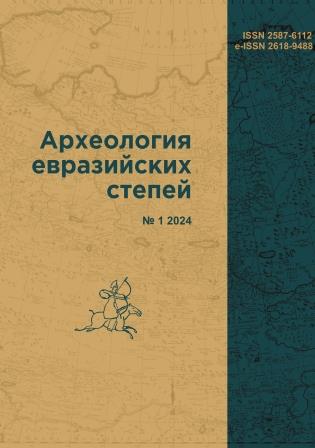Early Chersonesus Population Characteristics based on the Anthropological Materials from the Excavations by G.D. Belov
DOI:
https://doi.org/10.24852/2587-6112.2024.1.177.187Keywords:
archaeology, bioarchaeology, paleopopulations, paleopathology, Northern Black Sea region, ancient Greek colonies, V–IV centuries BCAbstract
The article presents the results of a study of the materials from the necropolis of the Chersonesus fortified settlement, dated V–IV centuries BC. 70 individuals were examined, the main attention was paid to determining the key demographic and paleopathological features of the group. The distribution of mortality rates is consistent with the standard for paleopopulations, both within the entire group and for its male and female subsets. The group is characterized by early age at death, moderately high infant (under 15) mortality, and a low proportion of elderly population. A high occurrence of routine non-lethal injuries cases as well as the cribra orbitalia prevalence might be defined as a notable feature of the group based on the results of the paleopathological analysis. All identified characteristics may reflect the group's adaptation to the new living conditions during the initial stages of the colony growth.
References
Alekseev, V. P. 1966. Osteometriia. Metodika antropologicheskikh issledovanii (Osteometry. Anthropologic Research Technique). Moscow: “Nauka” Publ. (in Russian).
Alekseev, V. P. 1972. In Sovetskaia Arkheologiia (Soviet Archaeology) (1), 3–21 (in Russian).
Alekseev, V. P., Debets, G. F. 1964. Kraniometriia. Metodika antropologicheskikh issledovanii (Craniometry. Anthropologic Research Technique). Moscow: “Nauka” Publ. (in Russian).
Alekseeva, T. I., Bogatenkov, D. V., Lebedinskaya, G. V. 2003. Vlakhi. Antropo-ekologicheskoe issledovanie (po materialam srednevekovogo nekropolia Mistikhali) (The Vlachs. Anthropo-Ecological Study (Based on Materials from the Medieval Necropolis of Mistikhali)). Moscow: “Nauchnii mir” Publ. (in Russian).
Belov, G. D. 1938. Otchet o raskopkakh Khersonesa za 1935-36 gg. (Report on the excavations of Chersonesus for 1935-36). Simferopol: “Krymgosizdat” Publ. (in Russian).
Buzhilova, A. P. 1995. Drevnee naselenie: paleopatologicheskie issledovaniia (Ancient Population: Paleopathological Studies). Moscow: Institute of Archaeology, Russian Academy of Sciences (in Russian).
Vinogradov, Yu. G., Zolotarev, M. I. 1998. In Khersonesski sbornik (Chersonesos collected papers) 9. Sevastopol, 36–46 (in Russian).
Dobrovolskaia, M. V., Svirkinа, N. G. 2018. Zhiteli antichnoy Fanagorii (rekonstruktsiya obraza zhizni po paleoantropologicheskim materialam) (Ancient Phanagoria population (reconstruction of the lifestyle, based on the paleoanthropological materials). Moscow: “ KMK” Publ. (in Russian).
Zubar, V. M. et al. 2005. Khersones Tavricheskiy v tret'ey chetverti VI – seredine I vv. do n.e. Ocherki istorii i kul'tury (Chersonesus in the third quarter of the VI – middle of the I century BC. Essays on history and culture). Kiev: “Akademperiodka” Publ. (in Russian).
Ivanov, A. V. 2016. Naselenie antichnogo Khersonesa Tavricheskogo – vizantiyskogo Khersona po dannym antropologii (Ancient Tauric Chersonesos population – Byzantine Cherson, based on the anthropological materials). Sevastopol: “Albatros” Publ. (in Russian).
Ivanov, A. V. 2011. In Alekseenko, N. A. (ed.). Khersonesski sbornik (Chersonesos collection) 16. Sefasopol: Institute of Archaeology, National Academy of Sciences of Ukraine, 105–116 (in Russian).
Dobrovolskaia, M. V. 2020. Metodika raboty s paleoantropologicheskimi materialami v polevykh usloviyakh (Methodology for Working with Paleoanthropological Materials in the Field). Moscow: Institute of Archaeology, Russian Academy of Sciences (in Russian).
Nazarova, T. A. 2016. In Veles (34), 4–1, 45–49 (in Russian).
Stoyanov, R.V. 2004. Nekropol' Khersonesa Tavricheskogo V–I vv. do n.e. (Chersonesus necropolis of the V–I centuries BC). Diss. of Candidate of doctor of Historical Sciences. Saint Petersburg: Kiev University named after Taras Shevchenko (in Russian).
Angel, J. L. 1966. In Science.153 (3737), 760–763.
Boel, L. W. T., Ortner, D. J. 2013. In International Journal of Osteoarchaeology 23 (3), 303–309.
Henneberg, M., Henneberg, R. J. 2001. In Problemi della chora coloniale dall'Occidente al Mar Nero: Atti del quarantesimo Convegno di studi sulla Magna Grecia, Taranto, 29 settembre-3 ottobre 2000. Taranto: Istituto per la storia e l'archeologia della Magna Grecia, 461–484.
Keenleyside, A., Panayotova, K. 2006. In International Journal of Osteoarchaeology 16 (5), 373–384.
Kyle, B. et al. 2018. In American Journal of Physical Anthropology 167 (1), 161–172.
Ortner, D. J. 2003. Identification of Pathological Conditions in Human Skeletal Remains. Ed. 2. Academic Press.
Rathmann, H., Stoyanov, R., Posamentir, R. 2022. In International Journal of Osteoarchaeology 32 (1), 49–63.
Schepartz, L. A. 2010. In The Complex of Tumuli 9 (10), 48–77.
Stuart-Macadam, P. 1985. In American Journal of Physical Anthropology 66 (4), 391–398.
Sulosky Weaver, C. L., Di Stefano, G. 2015. The Bioarchaeology of Classical Kamarina: Life and Death in Greek Sicily. Gainesville: University Press of Florida.
Ubelaker, H. D. 1978. Human Skeletal Remains. Excavation, Analysis, Interpretation. Washington DC: Taraxacum.
Walker, P. L. et al. 2009. In American Journal of Physical Anthropology 139 (2), 109–125.

Downloads
Published
How to Cite
Issue
Section
License
Copyright (c) 2024 A.D. Buriak

This work is licensed under a Creative Commons Attribution-NonCommercial 4.0 International License.







